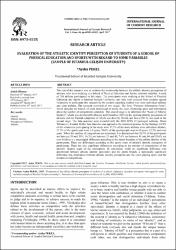| dc.contributor.author | Pekel, Aydın | |
| dc.date.accessioned | 2019-01-25T07:18:27Z | |
| dc.date.available | 2019-01-25T07:18:27Z | |
| dc.date.issued | 2017-04 | |
| dc.identifier.issn | 2501-1111 | |
| dc.identifier.uri | http://hdl.handle.net/11363/1000 | |
| dc.description.abstract | The aim of this research was to evaluate the relationship between the athletic identity perceptions of athletes, who were studying in a School of Physical Education and Sports, selected variables. A total of 288 athletes participated in this study. The participants were studying at the School of Physical Education and Sports at Istanbul Gelişim University, and they were selected from students agreed voluntarily to participate this research by the random sampling method who were individual athletes and team athletes. The research consisted of two stages. The first, “Personal Information Form”, which includes the branch of sport (individual or team), the years of playing sport and information about the number of competitions attended. The second stage is to determine the “Scale of Athletic Identity”, which was developed by Brewer and Cornelius (2001) is the sporting identity perceptions of athletes, and the Turkish adaptation of which was done by Öztürk and Koca (2013), was used in the second stage. The data acquired were recorded with the IBM SPSS 22 packaged software. Mann Whitney U, Kruskal Wallis Test Statistics was applied as the statistical process. In the findings, 62.8% of the volunteers participating in the study were 37.2% of the team athletes were individual athletes, 37.5% of the sports year were 1-5 years, 50.0% of the sportspeople were 6-10 years, 12.5% and over years. When the number of competitions are examined, it is determined that 20.5% of the participants are between 20 and 20%, 16.3% are between 21 and 40, 7.6% are between 41 and 60 and 55.6% are over 61.there is a meaningful difference according to the sports branches of the athlete identity of the participants. There are differences according to the sports years of athlete's identity perception of participants. There are also significant differences according to the number of competitions of the athlete's identity aegis of the participants. In conclusion, while no significant difference was determined between athletic identity perception and the sports branch, a statistically significant difference was determined between athletic identity perception and the years playing sport, and the number of competitions. | en_US |
| dc.language.iso | eng | en_US |
| dc.publisher | International Journal of Current Research | en_US |
| dc.rights | info:eu-repo/semantics/openAccess | en_US |
| dc.rights | Attribution-NonCommercial-NoDerivs 3.0 United States | * |
| dc.rights.uri | http://creativecommons.org/licenses/by-nc-nd/3.0/us/ | * |
| dc.subject | Research Subject Categories::SOCIAL SCIENCES | en_US |
| dc.title | Evaluation of the Athletic İdentity Perception of Students of A School of Physical Education and Sports With Regard to Some Variables (Sample of İstanbul Gelişim University) | en_US |
| dc.type | article | en_US |
| dc.relation.ispartof | International Journal of Current Research | en_US |
| dc.department | İstanbul Gelişim Üniversitesi | en_US |
| dc.identifier.volume | 9 | en_US |
| dc.identifier.issue | 4 | en_US |
| dc.identifier.startpage | 48982 | en_US |
| dc.identifier.endpage | 48985 | en_US |
| dc.relation.publicationcategory | Kategori Yok | en_US |



















